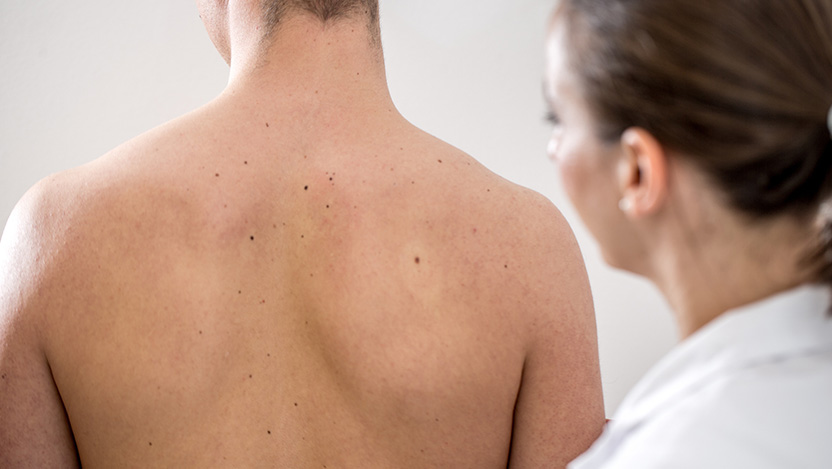Mole Mapping: Detect Skin Cancer Early

Mole mapping, also known as total body photography, is a painless, safe, noninvasive approach to help detect melanoma, a dangerous skin cancer. It utilizes photography to record images of the whole body. These images provide dermatologists with a side-by-side comparison of early cancerous moles over time, allowing them to better monitor and track changes such as structure, color and size.
The Importance of Detecting Skin Cancer Early
Changes can be an early sign of melanoma. Early detection is important because melanoma is very treatable in its early stages. When melanoma is detected and removed before it spreads, the cure rate is over 95 percent. Mole mapping also has the potential to reduce the number of unnecessary biopsies for growths that may have slight irregularities that are stable over time and are benign.
Your First Visit to the Clinic for a Mole Mapping Appointment
A pigmented lesions care team member takes up to 20 digital photos of the patient’s entire skin surface. Then the dermatologist looks for any suspicious moles that should be watched over time. Close-up digital dermatoscopic images of concerning moles are taken at this time. Photographs are stored in a secure database so they can be reviewed for changes at the next visit, which is usually scheduled for 6 to 12 months later.
To prepare for your visit:
- Perform a self-exam and note any new, changing or unusual spots to show the dermatologist.
- Keep in mind the ABCDE’s:
- Asymmetry
- Borders are irregular
- Colors: may have multiple colors
- Diameter greater than ¼ inch
- Evolution of moles
- Discontinue use of any self-tanner/spray tans for one to two weeks before your exam. They may alter the color and pattern of your moles.
- Remove nail polish so the dermatologist can examine the nails on your fingers and toes.
- Wear your hair down so the dermatologist can take a close look at your scalp.
- Do not wear makeup to the visit, or use face wash at the clinic to remove makeup before your exam.
- Do put on moisturizer, which may help normalize the pattern of the moles if your skin is dry.
- Be prepared with questions, such as how to do properly do a skin self-exam.
To inquire about mole mapping or to schedule an appointment, call 773-702-1611.
Frequently Asked Questions about Mole Mapping
Mole mapping may be recommended for people who have a higher risk of melanoma, including those with some of the following:
- A history of atypical moles called dysplastic nevi, which may have an irregular shape or an uneven color
- More than 50 moles
- A family or personal history of melanoma
- A history of severe sunburns
Your dermatologist may biopsy or remove part or all of the mole and send it to a lab for analysis. If the mole is found to be melanoma, they will contact you to explain the type of melanoma and treatment options.
Many dermatologists recommend checking your own skin regularly, or about once a month. Regular skin self-exams are especially important for people who are at higher risk of skin cancer. This includes those who have reduced immunity, have had skin cancer, or have a strong family history of skin cancer. Talk to your dermatologist about how to do a self-exam and how often you should examine your skin. For most patients, we recommend a full skin exam by your dermatologist at least once a year.
It depends on your insurance plan and may require prior authorization. Factors that increase your risk for melanoma may influence your insurance coverage. These factors may include: a previous history of atypical or dysplastic nevi (moles), or melanoma; a genetic predisposition to melanoma; or a family history of melanoma. Our mole mapping services are also available as a self-pay visit in case it is not covered by your insurance.
Some moles may disappear with increasing age.
Moles can develop at any age. It is more common to develop moles as a child and during puberty. The number of new moles you develop may peak in your 30s to 40s. The number of moles you have and will develop can be influenced by genetics, history of sun exposure and other factors. It is also important to know that not all brown or dark brown spots are moles. Over time, your skin may develop other growths that have colors or shapes similar to moles. These include "sunspots" or solar lentigines and seborrheic keratoses, common noncancerous (benign) skin growths.
Moles are not necessarily bad; however, having a large number of moles (more than 50) or atypical moles can increase the risk for melanoma. Sun can increase the number of moles, especially on sun-exposed skin. Depending on your sun exposure history and genetic history, increased exposure to the sun can increase your risk for other types of skin cancers such as basal cell and squamous cell carcinoma. It’s important to wear sunscreen daily (and reapply as directed), wear sun-protective clothing, stay in the shade, and try to avoid sun exposure between the peak hours of 10 a.m. and 4 p.m. If any moles or growths change size, shape, color or start to bleed, see a dermatologist — regardless of how long you’ve had the growth.
The mole may not come back, or it may grow back with a similar appearance. It may also grow back with a different appearance as a result of the healing process or scarring. If the mole looks different or unusual as it heals or after it has healed, you may want to have your dermatologist examine the growth.


